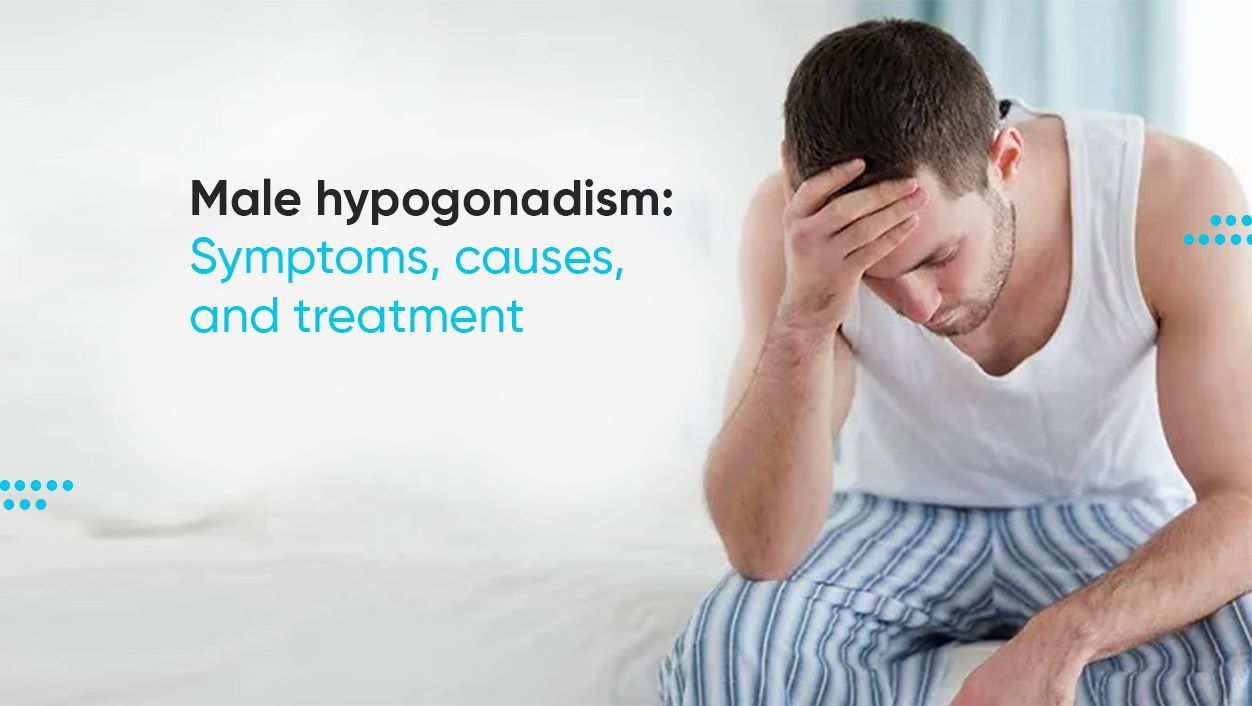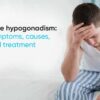Male hypogonadism is a disorder in which the body does not generate enough testosterone, which is important for male growth and development throughout puberty, or enough sperm, or both.
Male hypogonadism can be inherited or develop gradually as a result of an accident or infection. The consequences — and what you’ll do about them —variate depending on the cause and when male hypogonadism strikes. Testosterone replacement therapy can be used to treat certain kinds of male hypogonadism.
Indications:
Hypogonadism can arise during pregnancy, before puberty, or later in life. The signs and symptoms of the illness vary depending on when it manifests.
Development of the foetus:
If the body cannot produce sufficient testosterone during foetal development, the outer sex organs may not grow properly. A genetically male infant may be born with one or more of the following traits, depending on when hypogonadism occurs and how much testosterone is evidencing
sexual organs of women
Male and female genitals that aren’t unmistakably male or female
Male genitals that aren’t fully grown
Puberty
Male hypogonadism can cause puberty to be delayed as well as incomplete or non-normal development. It may obstruct:
Muscle mass development
Deepening of voice
Hair growth on the body and on the face
Penis and testicle development
And it has the potential to cause:
Excessive development of the arms and legs compared to the body’s trunk
Breast tissue development
Adulthood
Hypogonadism in adult males can affect certain masculine physical traits as well as normal reproductive function. The following are examples of early indications and symptoms:
Sex drives have dwindled.
Reduced energy
Despair
Men with hypogonadism can develop the following new symptoms over time:
Fertility issues
Hair growth on the body and face is decelerating.
Muscle mass decreases.
Gynecomastia
Bne resorption
Extreme hypogonadism can also affect the mind and emotions. As testosterone levels drop, some men have signs that are comparable to those of women going through menopause. These can include the following:
Concentration problems
Flashes of heat
When should you seek assistance?
If you’re experiencing signs of male hypogonadism, see your physician. The first step in finding the right treatment for hypogonadism is to figure out what’s causing it.
Male hypogonadism occurs when the testicles do not generate enough testosterone, the male sex hormone. Hypogonadism can be divided into two categories: male hypogonadism and female hypogonadism.
Primary: An issue in the testicles causes this type of hypogonadism, also known as primary testicular failure.
Secondary: This sort of hypogonadism implies an issue with the hypothalamus, or pituitary gland, which controls testosterone production in the testicles. The brain makes gonadotropin-releasing hormone, which instructs the pituitary gland to release FSH and luteinizing hormone. The testes are then signalled to manufacture testosterone by the luteinizing hormone.
An inherited feature or anything that occurs later in life, such as an infection or injury, can induce either form of hypogonadism. Primary and secondary hypogonadism can develop at the same time.
Hypogonadism is a condition that affects both men and women.
The following are some of the most likely reasons for primary hypogonadism:
Klinefelter syndrome is a condition that affects people. This disorder is caused by a congenital disorder of the X and Y chromosomes. A male has one X and one Y chromosome by default. Two or more X chromosomes, as well as one Y chromosome, are present in Klinefelter syndrome.
The Y chromosome is home to the genetic information that defines a child’s sex and subsequent development. The extra X chromosome that arises in Klinefelter syndrome induces aberrant testicular development, which leads to testosterone underproduction.
Testicles that haven’t descended The testicles form inside the abdomen before birth and usually travel down into their permanent location in the scrotum. When a child is born, one or both testicles may not be descended.
Without therapy, this issue frequently rectifies itself within a few years of life. This can lead to testicular dysfunction and diminished testosterone production if not addressed in early development.
Orchitis in mumps: During adolescence or adulthood, a mumps infection affecting the testicles can cause damage to the testicles, compromising their function and testosterone production.
Hemochromatosis: A high level of iron in the blood can lead to testicular dysfunction or pituitary gland malfunction, both of which impact testosterone production.
The testicles have been injured. The testicles are vulnerable to harm since they are located outside the abdomen. Hypogonadism can be caused by damage to both testicles. An injury to one testicle may not affect testosterone output overall.
Treatment for cancer: Chemotherapy and radiation therapy used to treat cancer can cause testosterone and sperm generation to be disrupted. Both therapies have transient effects, but permanent infertility is possible.
Although many men restore their fertility after a few months of treatment, men can choose to preserve their sperm before beginning cancer treatment.
Hypogonadism secondary to hypogonadism primary
The testicles are normal in secondary hypogonadism, but they don’t function properly due to an issue with the pituitary or hypothalamus. Secondary hypogonadism can be caused by a variety of factors, including:
Kallmann’s syndrome is a condition that affects people. This is an aberrant development of the brain region that controls pituitary hormone output. This condition can impair one’s sense of smell.
This condition can impair one’s sense of smell.
Pituitary diseases are a group of conditions that affect the pituitary gland. The transfer of hormones from the pituitary gland to the testicles might be hampered by a pituitary gland abnormality, reducing normal testosterone production. A pituitary tumour or another sort of brain tumour near the pituitary gland might result in a testosterone or even other hormone deficiency.
Surgery or radiation treatment for a brain tumour can also impact the pituitary gland, resulting in hypogonadism.
Inflammatory bowel disease: Certain inflammatory disorders, such as sarcoidosis, histiocytosis, and tuberculosis, influence testosterone production by affecting the hypothalamus and pituitary glands.
HIV/AIDS: By impacting the hypothalamus, pituitary, and testes, HIV/AIDS can result in decreased testosterone levels.
Medications: The use of some substances, such as opiates and hormones, can have an impact on testosterone production.
Obesity: Hypogonadism may be connected to being severely overweight at any age.
geing:The production of testosterone in males decreases gradually as they age. The rate fluctuates a lot.
Factors that are at risk
Hypogonadism can be caused by a number of reasons, including:
Aids
previous chemo or radiation treatment
Ageing
Overweight
Malnourishment
Hypogonadism can be passed down through the generations. Tell your doctor if you have a family history of any of these risk factors.
Concerns:
Untreated hypogonadism has different consequences depending on when it appears: during foetal development, puberty, or adulthood.
Complications could include the following:
genitalia that are malformed
Male breasts that are too big
Infertility
Eectile dysfunction
Bone loss
Self-esteem issues
Treatment
When it comes to treating male hypogonadism, there are several options to consider. These may include:
-
Hormone Replacement Therapy: This involves the use of testosterone replacement to supplement low hormone levels. Various forms, such as gels, injections, patches, or pellets, are available.
-
Medications: Certain medications may be prescribed to stimulate the body’s natural testosterone production or manage related symptoms.
-
Lifestyle Changes: Incorporating healthy habits like regular exercise, maintaining a balanced diet, managing stress, and getting enough sleep can have a positive impact on overall well-being.
-
Fertility Treatments: In cases where fertility is a concern, assisted reproductive techniques may be explored under the guidance of a healthcare professional.
It’s important to consult with a qualified healthcare provider to discuss individual circumstances and determine the most suitable treatment approach for male hypogonadism.
Conclusion: Understanding male hypogonadism is crucial for men’s health and overall well-being. Recognising the symptoms and seeking a proper diagnosis is the first step towards effective treatment. With various treatment options available, including hormone replacement therapy and lifestyle adjustments, men can regain their vitality and improve their quality of life.
If you have any doubts on this topic, feel free to contact us for more information.






